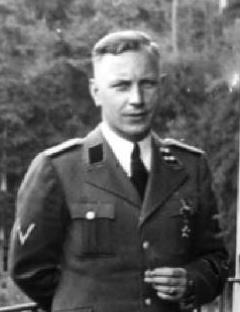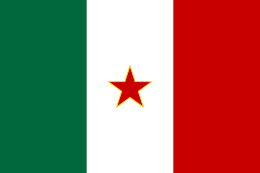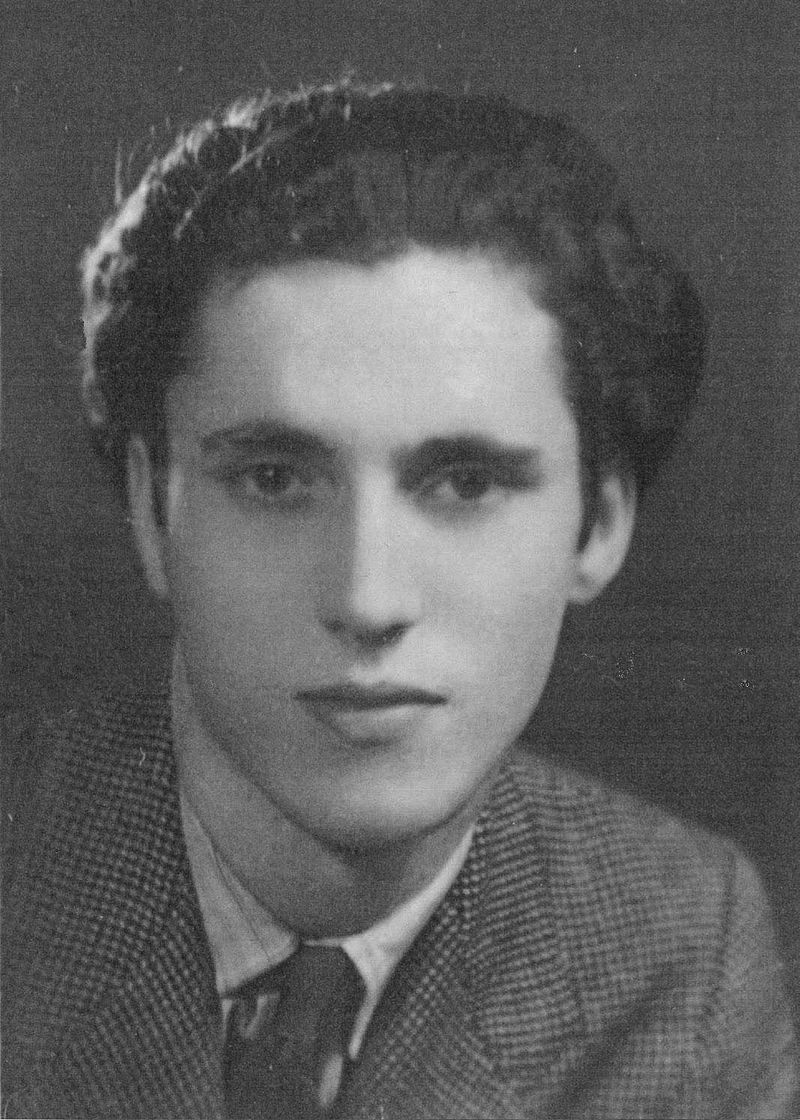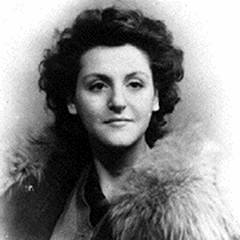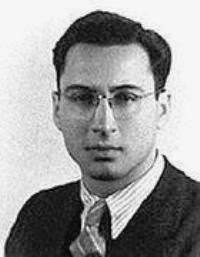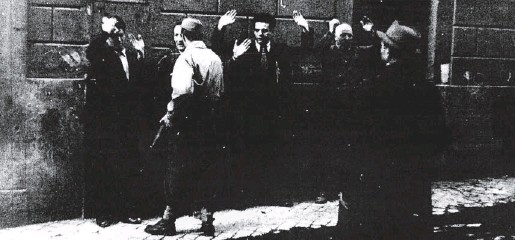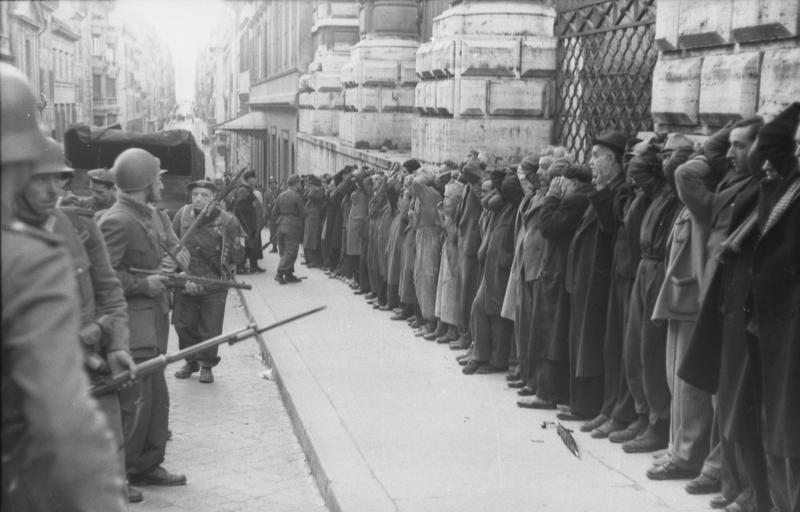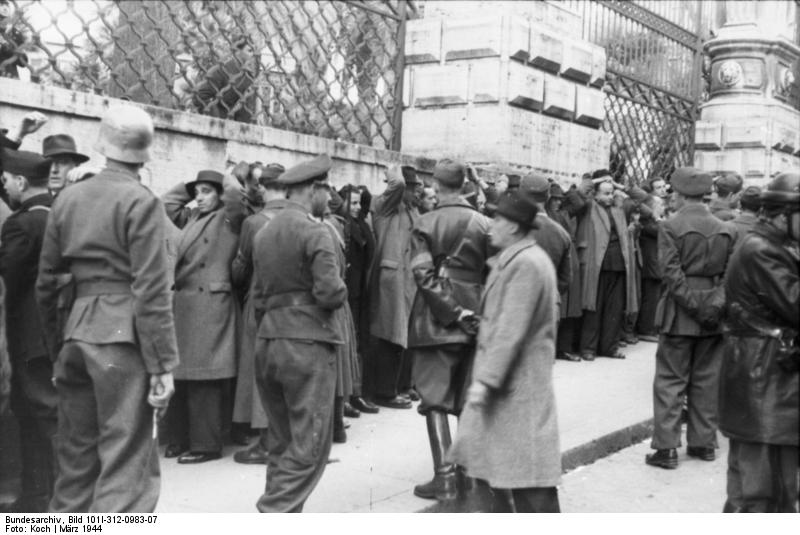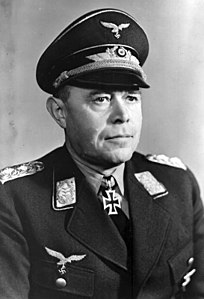3.52 p.m. 23 March 1944. Rosario Bentivegna (photo) is standing next to a street cleaner& #39;s handcart in via Rasella, central Rome, nervously smoking a pipe. The handcart contains a powerful rudimentary bomb & he is about to set in motion a series of terrible events [Thread] >> 1
Since Italy& #39;s surrender to the Allies on 8 September 1943, Rome has been occupied by German troops, who keep order under Herbert Kappler (photo), SD Commander in the city, with the help of Italian police & troops loyal to Mussolini& #39;s new Italian Social Republic >> 2
Various Italian partisan groups have been formed in the city to offer resistance to the German occupation. By far the most active among these groups are the communist inspired "Gruppi di Azione Patriottica" (GAP), often in contrast with other groups they consider too passive >> 3
German and Italian Fascist troops carry out frequent sweeps to round up men for forced labour, hunting for suspected partisans or draft dodgers, creating an atmosphere of fear. On 16 October 1943, 1,259 Jews are rounded up in the Rome ghetto & most are deported to Auschwitz >> 4
There is considerable debate among partisan groups about whether to favour passive or active reistance, especially since the Allied landings at Anzio on 22 January 1944, which give the impression it is only a question of time until Rome is liberated >> 5
Moderate groups counsel passive resistance in order not to provoke reprisals on civilians. An attempted uprising by communist partisans & supporters of the Partito d& #39;Azione in the aftermath of Anzio fails & many partisan leaders, such as Pilo Albertelli (photo) are captured >> 6
The population is war weary, preoccupied with finding enough food to eat & there is little enthusiasm for direct attacks on German troops, however much they may be despised. GAP partisans, nonetheless, continued to carry out attacks despite the risk of reprisals >> 7
Indeed, the killing of a German soldier by GAP on 31 January, and of another on 5 March, is followed on each occasion by the execution of 10 prisoners (captured partisans or political prisoners) by German forces in reprisal. This proportion of 10:1 is to come into play again >> 8
The GAP react to these reprisals by toughening their stance. On 10 March 1944, Italian Fascists commemmorate the death of Giuseppe Mazzini with a march of militia groups. GAP partisans attack the march in via Tomacelli using hand grenades, killing three & wounding others >> 9
Encouraged by this success, another attack is planned against another march scheduled for 23 March to commemorate the 25th anniversary of the founding of the Fascist Party. This time the assault is to involve partisans from the socialist Brigate Matteoti in a dual attack >> 10
The socialist partisans in Rome are commanded by Sandro Pertini, future President of Italy (1978-85), who has recently escaped from prison, where he was awaiting execution along with another future President, Giuseppe Saragat (see linked thread) >> 11 https://twitter.com/NickWhithorn/status/1353401693262786562?s=20">https://twitter.com/NickWhith...
It is decided that Brigate Matteoti will carry out the main attack on the Italian Fascist march, while GAP will attack a German military police column at the same time. The GAP have been observing movements of this Company of military police in order to plan their attack >> 12
For several days, 4 members of GAP have observed the movements of this Company. The four are Lucia Ottobrini (nickname "Maria", photo top left), Mario Fiorentini ("Giovanni", top right), Carla Capponi ("Elena", bottom left) & Rosario Bentivegna ("Paolo", bottom right) >> 13
The Company in question is 11th Company & #39;Polizeiregiment Bozen& #39;. These are not battle-hardened troops but German & Ladin speaking conscripts from the Italian Südtirol region forced to enlist when German troops occupied the region following Italy& #39;s surrender in autumn 1943 >> 14
The Company is quartered in the Viminale (Italian Interior Ministry) and every day the 156 men march to the Tor di Quinto firing range on the outskirts of Rome for training. The partisans ascertain that the column marches along via Rasella on its return around 2 p.m. >> 15
Via Rasella is chosen because it is a narrow street (see modern day photo below from point at which the bomb was placed) along which the troops will march uphill. Thus, the effect of the blast will be amplified and room for manoeuvre limited >> 16
Moreover, the street is not very busy, especially at 2 p.m. when the column passes along it because shops are closed. This reduces the risk of civilian casualties and the chances of discovery >> 17
Problems begin to arise in the days preceding the attack. Rumours begin to circulate that, following a speech by the Pope on 12 March pleading for the city to be spared, German troops will leave Rome so that the Allies will not bomb the city >> 18
The GAP partisans notice that 11th Company Polizeiregiment Bozen no longer passes along its route every day. The column fails to appear on 18th & 19th March but reappears on 20th & 21st. Then, it fails to show again on 22nd. There are fears it may be preparing to pull out >> 19
On the evening of 22nd March, the bomb is placed inside the stolen handcart. The device consists of 12kg of TNT packed into a metal container with 6kg more of explosive placed alongside with loose pieces of metal to produce a shrapnel effect >> 20
On the morning of 23 March 1944 the 11th Company column is seen marching out to Tor di Quinto at its usual time & along its usual route, so preparations begin to strike it on its return in the afternoon >> 21
Meanwhile, at midday, the attack to be carried out by Brigate Matteotti on the Fascist Party march is called off. Following the assault on the previous march in via Tomacelli, the German authorities convince the Italian Fascists to call it off & hold an indoor rally >> 22
The via Rasella attack goes ahead. 17 GAP partisans take part. Bentivegna, dressed as a street cleaner is given the task of taking the handcart to the scene & lighting the fuse. Carla Capponi waits at the end of the street with a coat to cover his uniform & help him escape >> 23
Fernando Vitagliano, Francesco Curreli, Raoul Falcioni & Guglielmo Blasi are situated on the steps facing the junction with via del Boccaccio (the only side street running off via Rasella). They are armed with Brixia mortar shells adapted for use as hand grenades >> 24
Others are there to cover the escape. The photo below of GAP members in Rome shows some of them. Those circled in red participated in the via Rasella attack >> 25
The partisans& #39; nerves are severely tested as the Polizeiregiment Bozen column doesn& #39;t appear at its usual time of 2 p.m. Indeed, on that day the column leaves Tor di Quinto late & the & #39;Gappisti& #39; have to wait almost two hours longer >> 26
Then, at 3.52 p.m., Franco Calamandrei (photo) standing at the junction with via del Boccaccio removes his hat, signalling that Bentivegna should light the fuse. Bentivegna uses his pipe to do so and hurries away towards Carla Capponi. The explosion is 50 seconds away >> 27
As it is now almost 4 p.m., time for shops to open, the street is busier than it would be at 2 p.m. As he hurries away, Bentivegna stops a some workers heading towards the bomb. To the partisans& #39; horror, they see a group of children following the column, playing at soldiers >> 28
At the risk of being discovered, some of the partisans intervene to stop the children & chase them away to avoid their being caught in the explosion.
The blast is as devastating as expected. The effect is heightened by the explosion of grenades attached to soldiers& #39; belts >> 29
The blast is as devastating as expected. The effect is heightened by the explosion of grenades attached to soldiers& #39; belts >> 29
After the blast the partisans throw their grenades & briefly exchange gunfire with the German troops. None of the partisans are wounded or captured. Shocked & disoriented, the surviving troops continue to fire at upper floors of buildings, convinced the attack is from above >> 30
In the immediate aftermath, 26 men of Polizeiregiment Bozen lie dead in via Rasella. Others die of wounds over the following hours. By 8 a.m. on 24 March, 32 are dead. A 33rd dies later that day. As the thread continues we will see numbers & timing of deaths are important >> 31
In addition, six Italian citizens die in the attack, one of them, Piero Zuccheretti, just 12 years old. He & another are killed by the explosion, the other four die in the street or buildings as a result of gunfire from the German troops afterwards >> 32
This thread will continue tomorrow, recounting the aftermath of the attack and the even more terrible events in Rome the next day, 24 March 1944, when far more Italian civilians die as a direct consequence of the attack in via Rasella >> 33
Immediately after the attack, authorities begin to arrive in via Rasella: General Kurt Mälzer, military Commander in Rome, SS Commander Herbert Kappler, German Consul General Möllhausen, Interior Minister of the RSI Buffarini Guidi & Police Chief Pietro Caruso >> 34
German troops are still firing indiscriminately and Caruso& #39;s driver Erminio Rossetto, who gets out of their car holding a pistol & wearing plain clothes, is mistaken for a partisan, shot & killed. The scene is one of carnage and General Mälzer is furious >> 35
According to some on the scene he is drunk and, in a rage, he orders all the buildings in that stretch of via Rasella to be blown up with explosives & a truck arrives with the material necessary. Only when Kappler arrives & takes control of the situation does he calm down >> 36
German and Italian RSI troops begin to round people up on the streets in the area and from the buildings in via Rasella (photos). They are lined up against the railings of Palazzo Barberini and taken away for interrogation. Over 300 are held in the basement of the Viminale >> 37
The question of reprisal is immediately discussed. Fieldmarshal Kesserling cannot be reached as he is at the Anzio bridgehead but his office contacts Rastenburg & refers that Hitler has ordered the killing of 30 to 50 Italian civilians for every dead German soldier >> 38
No official records exist to confirm Hitler& #39;s orders and the final decision on reprisal is taken by Kesserling on his return to Rome in the late evening of 23 March, after consulting Mälzer, Kappler & General Alfred Jodl in Rastenburg >> 39
It is decided to kill 10 Italian civilians for every dead German soldier. The operation is to take place in secret, no appeal is to be made for the partisans to give themselves up or for the population to turn them in. The whole operation should be completed in 24 hours >> 40
Now begins a mad & surreal rush to compile a list of & #39;candidates& #39; for execution. At the earliest stage, 280 need to be found as 28 soldiers have then died. The first to be included are prisoners already sentenced to death & those accused of crimes carrying a death sentence >> 41
Throughout the night the Gestapo office in Rome, directed by Colonel Kappler & his adjutant Captain Erich Priebke (photo), work on the compilation of the list. The Rome Police Chief Caruso promises to provide a list of 50 names >> 42
The situation is complicated by the news that more German soldiers have died of their wounds during the night so, with 32 victims, it is now necessary to find 320 people to be executed. Jailed members of the Resistance & 75 Jews awaiting deportation are included in the list >> 43
Some of those rounded up in the area of via Rasella & considered "known communists" or "known antifascists" are added, as are jailed Italian army officers & carabinieri who remained loyal to the Badoglio government. By morning Kappler thinks he has completed his list >> 44
However, at 8 a.m. Police Chief Caruso has still not provided his list of 50 names. Caruso is summoned and arrives at 9.45 a.m. He provides just one name, a doctor convicted of black market activity. The meeting is heated and Caruso is given time until 2 p.m. to comply >> 45
Kappler then meets General Mälzer & Major Dobbrick, Commander of Polizeiregiment Bozen. Mälzer orders Dobbrick to carry out the executions using his men belonging to the regiment attacked in via Rasella but Dobbrick expressly refuses to obey the order >> 46
As mentioned previously, his men are reluctant conscripts, mostly aged over 30, from the Italian Südtirol region. Most are deeply religious and would never participate in such an enterprise. Moreover, they are in a state of shock & mentally incapable of such a terrible task >> 47
Faced with this determined refusal, Mälzer orders Kappler to carry out the executions using his SS men and specifies that Kappler himself must participate directly in the killing to set an example to the others (to be continued) >> 48
Kappler returns to his HQ and informs his men of the task they have been given: the execution of 320 men (women were excluded from the list of victims from the outset). To carry this out, Kappler had 74 men at his disposal, himself included >> 49
A complex of abandoned underground tunnels in via Ardeatina on the south-eastern outskirts of the city is chosen as the site for the executions. Once completed, explosives will be used to collapse the entrance & hide the evidence >> 50
Kappler gives the job of directing the killings to Captain Carl Schütz, while Captain Priebke will check the names against the list. The order is that each execution is take "no more than one minute for each man." >> 51
At 1 p.m. a complication arises when Kappler learns that a 33rd soldier has died of his wounds following the via Rasella attack. He decides, on his own initiative, to add 10 more men to the list for execution in manic application of the orders he has received >> 52
The 10 extra men are taken from a group of Jews who have been captured since the original list has been compiled. This shows just how successful the authorities have been at maintaining secrecy. The Jewish community would be extra vigilant knowing that reprisals are planner >> 53
At 2 p.m. a convoy of trucks carrying the first group of condemned men leaves the prison in via Tasso & heads to the catacombs in via Ardeatina. There are three entrances to the tunnels, which are from 30m to 90m in length, 4m high & 3m wide >> 54
At 3.30 p.m. another convoy of trucks arrives from Regina Coeli prison & the executions begin. The victims are taken into the tunnels five at a time and Capt. Priebke checks their names against the list. Inside, they are forced to kneel & are shot in the back of the head >> 55
Kappler& #39;s men are not accustomed to using their weapons. They are normally occupied with bureaucratic police work and find this experience extremely harrowing. Kappler & Priebke take part in the executions, Priebke once, Kappler twice, to & #39;set an example& #39; >> 56
As the afternoon wears on, things become more chaotic. Some of those destined for execution put up resistance. The inexpert officers shooting them frequently fail to kill them instantly as they grow tired & sick at what they are doing >> 57
Kappler provides his men with brandy to dull their sensations, further reducing their effectiveness. The bodies begin to pile up, reducing the space until victims & executioners are kneeling or standing on a carpet of dead bodies >> 58
Kappler is still waiting for the 50 prisoners promised by Police Chief Caruso. At 4.30 p.m. he sends Lt. Tunnat to Regina Coeli prison, where he demands 50 prisoners. Caruso& #39;s list has still not arrived. He gathers 30, ten of whom will turn out not to be on Caruso& #39;s list >> 59
A few hours later, Tunnat returns to Regina Coeli, where Caruso& #39;s list has finally arrived. He collects the last 20 men & takes them to via Ardeatina. In the confusion created by the need to collect the final 50 prisoners, Priebke informs Kappler there are 5 more than needed >>60
Kappler orders the execution of these five extra men, as they have seen what is happening & are therefore inconvenient witnesses. At 8 p.m. the executions are finally over. 67 groups of 5. A Total of 335 men. The entrances to the tunnels are blocked by detonating explosives >> 61
After the war, relatives of some of the victims of the Fosse Ardeatine massacre brought a civil case against the organisers of the via Rasella attack, claiming damages on the basis that the attack caused the reprisal in which their relatives perished >> 62
At first instance, on appeal & in the Supreme Court of Cassation their claim was rejected, with judges at all three levels ruling the attack was to be considered a "legitimate act of war" >> 63
In 1997, a criminal case was brought against Rosario Bentivegna, Carla Capponi & Pasquale Balsamo for the death of 12-year-old Piero Zuccheretti & Antonio Chiaretti in the bomb explosion. Also in this case, judges upheld the legitimate act of war thesis >> 64
As for the perpetrators of the Fosse Ardeatine massacre, Field Marshal Kesserling (photo) was sentenced to death by a British Military Court in May 1947 for war crimes. The sentence was commuted to life imprisonment. He was released on health grounds in 1952 & died in 1960 >> 65
Herbert Kappler was tried by an Italian Military Court in 1948. The Court found that the order he received to kill 320 people in retaliation for the via Rasella attack was "illegitimate" >> 66
However, given the rigid discipline in the SS, the judges held that it was not proven that Kappler conciously & willingly carried out and illegitimate order. He was, nonetheless, convicted for the deaths of the additional 15 men, who died as a result of his direct orders >> 67
He was sentenced to life imprisonment, confirmed on appeal. In 1976, suffering from an incurable brain tumor, he was transferred to the Celio Military Hospital in Rome, following considerable pressure brought to bear by the German government >> 68
On 15 August 1977, with the help of his wife, he managed to escape from the hospital and found refuge in Germany, where his arrival was celebrated by neo-nazi groups. He died in 1978, a free man >> 69
Kappler& #39;s adjutant, Erich Priebke, fled to Argentina after the war. He was arrested there in 1995 & extradited to Italy. In 1997, he was sentenced to life imprisonment (photo). Due to his age, he spent his sentence under house arrest in a Rome flat, where he died in 2013 >> 70
The remains of the 335 victims are buried at the site of the massacre, which is open to the public >> 71
At the link below you can read the details of the victims of the Fosse Ardeatine massacre. Seven victims remain unidentified. Two victims, Marian Reicher & Heinz Erich Tuchmann were identified by DNA tests in 2020 // 72 ends http://www.mausoleofosseardeatine.it/vittime/ ">https://www.mausoleofosseardeatine.it/vittime/&...

 Read on Twitter
Read on Twitter![3.52 p.m. 23 March 1944. Rosario Bentivegna (photo) is standing next to a street cleaner& #39;s handcart in via Rasella, central Rome, nervously smoking a pipe. The handcart contains a powerful rudimentary bomb & he is about to set in motion a series of terrible events [Thread] >> 1 3.52 p.m. 23 March 1944. Rosario Bentivegna (photo) is standing next to a street cleaner& #39;s handcart in via Rasella, central Rome, nervously smoking a pipe. The handcart contains a powerful rudimentary bomb & he is about to set in motion a series of terrible events [Thread] >> 1](https://pbs.twimg.com/media/ExK-EuBUcAY1mWT.png)
